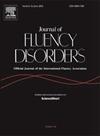口吃成人的工作记忆容量和反刍
IF 2.1
3区 医学
Q1 AUDIOLOGY & SPEECH-LANGUAGE PATHOLOGY
引用次数: 0
摘要
目的:难以丢弃工作记忆中激活的不相关的负面刺激与反刍的增加有关。与非口吃的成年人相比,口吃的成年人(AWS)报告了(a)对沟通事件的反思,以及(b)在需要操作工作记忆中保存的信息的任务中遇到的困难。考虑到反刍与工作记忆之间的联系,本研究考察了与反刍相比,AWS丢弃负面刺激的速度是否更快或更慢,以及丢弃负面信息的速度是否与广义反刍有关。方法为评估工作记忆与反刍的关系,26名被试(14名AWS, 12名AWS)完成了修改后的Sternberg任务。参与者首先记忆具有积极或消极情绪效价的单词表。然后,参与者被提示回忆一个特定的单词表,然后是一个与单词表匹配或冲突的提示词。比较两组间的手动响应延迟。结果saws和AWNS在丢弃不相关刺激时表现出相当的速度,两组丢弃消极不相关刺激的速度比积极不相关刺激慢。丢弃负面信息的延迟与AWS自我报告的反刍无关。结论初步数据显示,AWS和AWNS对负性刺激的调节速率无差异。此外,反刍似乎并不是唯一与负面信息被丢弃的速度相关的。有必要进行进一步的研究,以确定工作记忆在一些(但不是全部)口吃者所报告的重复性消极思维中所起的作用(如果有的话)。本文章由计算机程序翻译,如有差异,请以英文原文为准。
Working memory capacity and rumination in adults who stutter
Purpose
Difficulty discarding irrelevant negative stimuli activated in working memory has been linked to increased rumination. Adults who stutter (AWS) report (a) rumination about communication events, and (b) difficulties during tasks that require manipulation of information held in working memory compared to non-stuttering adults (AWNS). Given the link between rumination and working memory, this study examined whether AWS discard negative stimuli faster or slower compared to AWNS, and whether speed of discarding negative information is linked to generalized rumination.
Method
To assess the relationship between working memory and rumination, 26 participants (14 AWS, 12 AWNS) completed a version of the Modified Sternberg Task. Participants first memorized wordlists with positive or negative emotional valence. Participants were then cued to recall a specific wordlist, followed by a prompt word that either matched or conflicted with the wordlist. Manual response latency was compared between groups.
Results
AWS and AWNS exhibit comparable speed when discarding irrelevant stimuli, with both groups slower to discard negative rather than positive irrelevant stimuli. Latency of discarding negative information was not associated with self-reported rumination in AWS.
Conclusions
Preliminary data indicate no differences in the rate at which AWS and AWNS regulate negative stimuli. Additionally, rumination does not appear to be uniquely associated with the speed at which negative information is discarded. Further research is warranted to determine what role, if any, working memory has in the repetitive negative thinking reported by some, but not all, individuals who stutter.
求助全文
通过发布文献求助,成功后即可免费获取论文全文。
去求助
来源期刊

Journal of Fluency Disorders
AUDIOLOGY & SPEECH-LANGUAGE PATHOLOGY-REHABILITATION
CiteScore
3.70
自引率
14.30%
发文量
23
审稿时长
>12 weeks
期刊介绍:
Journal of Fluency Disorders provides comprehensive coverage of clinical, experimental, and theoretical aspects of stuttering, including the latest remediation techniques. As the official journal of the International Fluency Association, the journal features full-length research and clinical reports; methodological, theoretical and philosophical articles; reviews; short communications and much more – all readily accessible and tailored to the needs of the professional.
 求助内容:
求助内容: 应助结果提醒方式:
应助结果提醒方式:


